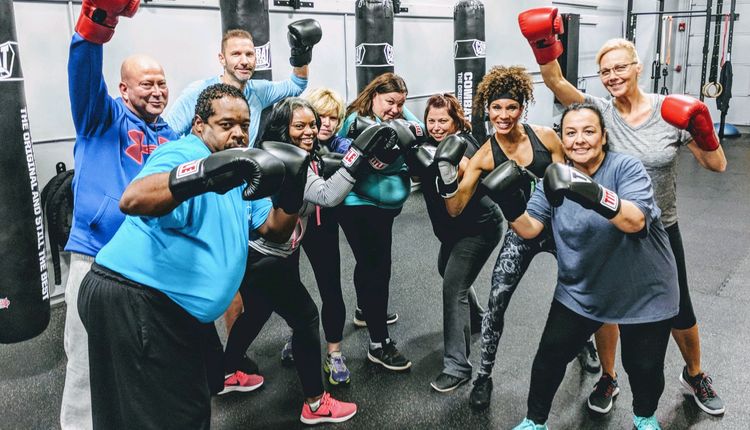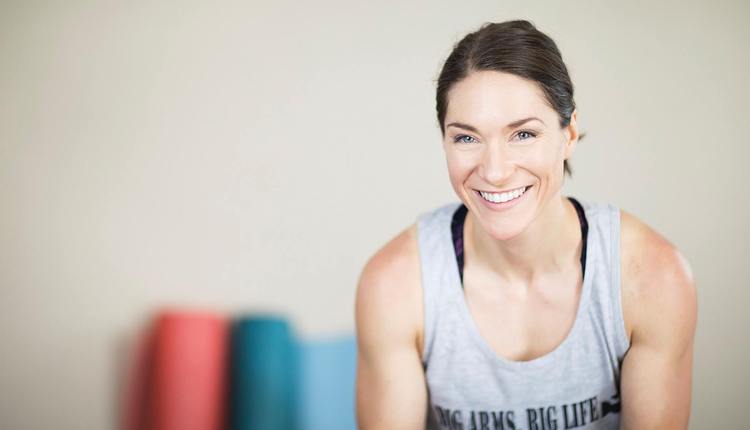Plyometric training is often called by the name "Stretch Shortening Cycle Exercise." This name actually describes the basic physiological basis for plyometric training: the muscle first goes through an eccentric action (stretching), then through an isometric action (static), and then through a concentric action (shortening). The goal is to perform the sequence quickly to result in a more powerful action than if no eccentric action (pre-stretch) was performed. An example would be to squat (eccentric action of quadriceps to a static action) and then jump (concentric action of quadriceps).
There are two theories as to why stretch shortening cycle exercise may produce more power:
-- The slight stretch stores more elastic energy which adds to the concentric action. This is the most commonly cited theory of why plyometric movements create more muscle force. The elastic energy is stored in the tendons and connective tissue.
-- A reflex results in quicker recruitment of muscle fibers or recruitment of more muscle fibers leading to a stronger contraction. This reflex recruitment possibly contributes but is not well understood yet. Regardless, stretch shortening cycle training does lead to development of power and vertical jump ability, making it desirable for athletic training.
Although plyometric training can be fun, it also has a high injury rate. Injuries are primarily attributed to bad flooring or landing surface, jumping from too high a platform or the client not being fit enough. This type of training is typically reserved for the very fit and those with sturdy joints. General guidelines for initiating plyometric exercise require that the client be able to back squat one and a half to two times their body weight to assure a good strength base necessary to reduce the risk of injury. Progression should be slow and volume low.
Plyometric exercises are not recommended for unfit clients as a general fitness and strength base is necessary to prevent joint stress.
It makes sense that performing plyometrics in the water would reduce injury rate; you have less force in landing and are not jumping from platforms. But if you look at the mechanics of jumping in the water, physiologically it is not the same. Reduced body mass from the water's buoyancy would tend to"lighten" the effects of plyometric jumps.
Interestingly enough, several research studies performed over the last decade show that plyometric training in the water indicated equal or better results than training on land with fewer injuries and less muscle soreness.
Benefits of Aquatic Plyometric Training
Various studies in the past few years have outlined the advantages of doing plyometric training in the water. Aquatic plyometric exercise provides the same performance enhancement benefits as land plyometric exercise but with significantly less muscle soreness reported with aquatic training as compared to land training. This may be because the buoyant properties of the water reduce impact and decrease risk of injury.
In two studies done by the Department of Health, Leisure and Exercise Science at Appalachian State University, a comparison of single leg jumps on land and in water measured with a force plate, impact force in the water was 44.85% lower compared to land. This indicates significantly less joint stress in the water.
Although the mechanism that makes aquatic plyometric exercise work is not fully understood, many researchers believe it is related to the drag properties of water that impede and therefore increase the intensity of the ascending movement of the vertical jump. The Appalachian State University's research indicated maximum strength in a single leg jump in the water was 44.95% higher compared to a land single leg jump. The drag forces of the water provide resistance for all submerged movements, and in particular for quick movements such as jumps performed at maximal effort.
Getting Started
Now that you understand the science behind aquatic plyometrics, here are some recommendations for starting a program.
The Audience: Research has shown that plyometric training can be a very successful workout with both male and female fit populations such as soccer, basketball and volleyball team members. It can make a great addition to the preseason training for most athletes, especially when done concurrently with resistance training.
The Water: The water level of the pool should be somewhere in the chest/armpit area of your clients. The water temperature should not exceed 30â°C or 86â°F. Wear aquatic shoes to prevent slipping and increase effectiveness of jumps.
The Workout: Consider adding one hour one to three times a week in an aquatic setting to an effective training program. Alternate jump sequence with lower intensity activities such as walking, toe tapping, shuffles, suspended movements, arm only movements or movements in place. Ninety to 140 foot contacts are recommended per session in bursts of 20-60 seconds, gradually increasing over time.
Sample Aquatic Plyometric Exercises
There are dozens of plyometric jump exercise which have been used in the water. Most programs are implemented without the use of a jump platform. Jumps in place, with turns, and traveling jumps are utilized. Here is a sampling of exercises.
-- Start with feet together. Jump, split legs, land with feet closed. The split can be to the side or front/back or a combination.
-- Start with feet apart. Jump, double or triple cross, land with feet open.
-- Start with feet together. Jumping jack three times then jump and turn 360 degrees.
-- Start with feet together. Jump side to side as if doing moguls. Increase intensity by lifting the knees and driving the feet down for jumps.
-- Start with feet together. Jump forward and back raising knees as if jumping over a large log.
-- Start with feet together. Jump and raise both knees to the front, land with feet together.
-- Start with feet together. Staying tall, jump and bring both heels behind (double leg curl), land with feet together.
Income Potential
There is income potential with aquatic plyometric training within the athletic community. Be sure that you are properly educated to personal train or group fitness train in the aquatic environment so you can provide a safe and, most importantly, effective program. They won't come back for more unless they see results. The Aquatic Exercise Association has the Aquatic Fitness Professional Manual and Certification program. (www.AEAwave.com) Exercise in the water is different than exercise on land due to the properties and physics of the water. In order to be successful, you need to be properly trained and knowledgeable about aquatic exercise.
Solicit athletic teams in your areas. Be well prepared to explain the benefits of aquatic plyometric training. With the compelling strength of existing research and lower injury potential, it should be easy to convince athletic teams to switch their plyometric training to the aquatic environment.
Have your business plan ready to go. Decide how much you will charge, how often and how long you will train, all necessary forms for liability and data collection, how payment will be made, etc. Having your business affairs well organized makes you look as professional as you are.
Get trained and properly execute before and after simple assessments to show progress and improvement over time. Consider using a vertical jump test or maximal/ submaximal leg strength assessments. If they see results they will bring you word of mouth business and come back for more. This is also a good way to make sure that your program is effective by seeing if it produces results.
As a certified or trained aquatic fitness professional, you can add plyometric training to your income earning possibilities. This is basically an untapped market potential. There is a shortage of qualified fitness professionals to train in the water. Expand your versatility and earning potential by considering work in the aquatic environment with fit and athletic individuals.
June Chewning is President and Educational Specialist for Fitness Learning Systems, a company offering quality continuing education products to health-fitness professionals at an affordable price. For more information on aquatic plyometrics or the studies that have been done, go towww.FitnessLearningSystems.com or email June at June@FitnessLearningSystems.com.

















